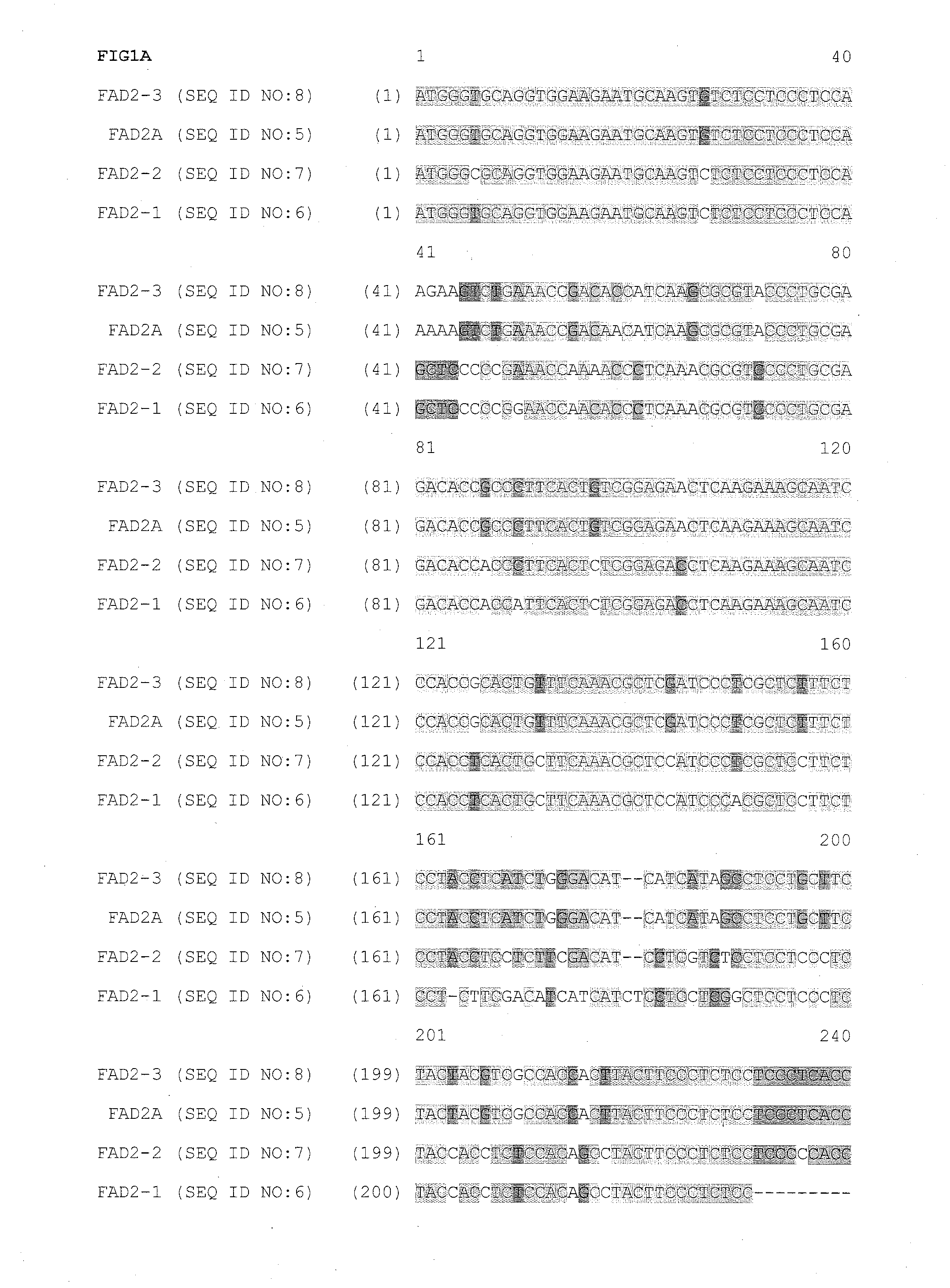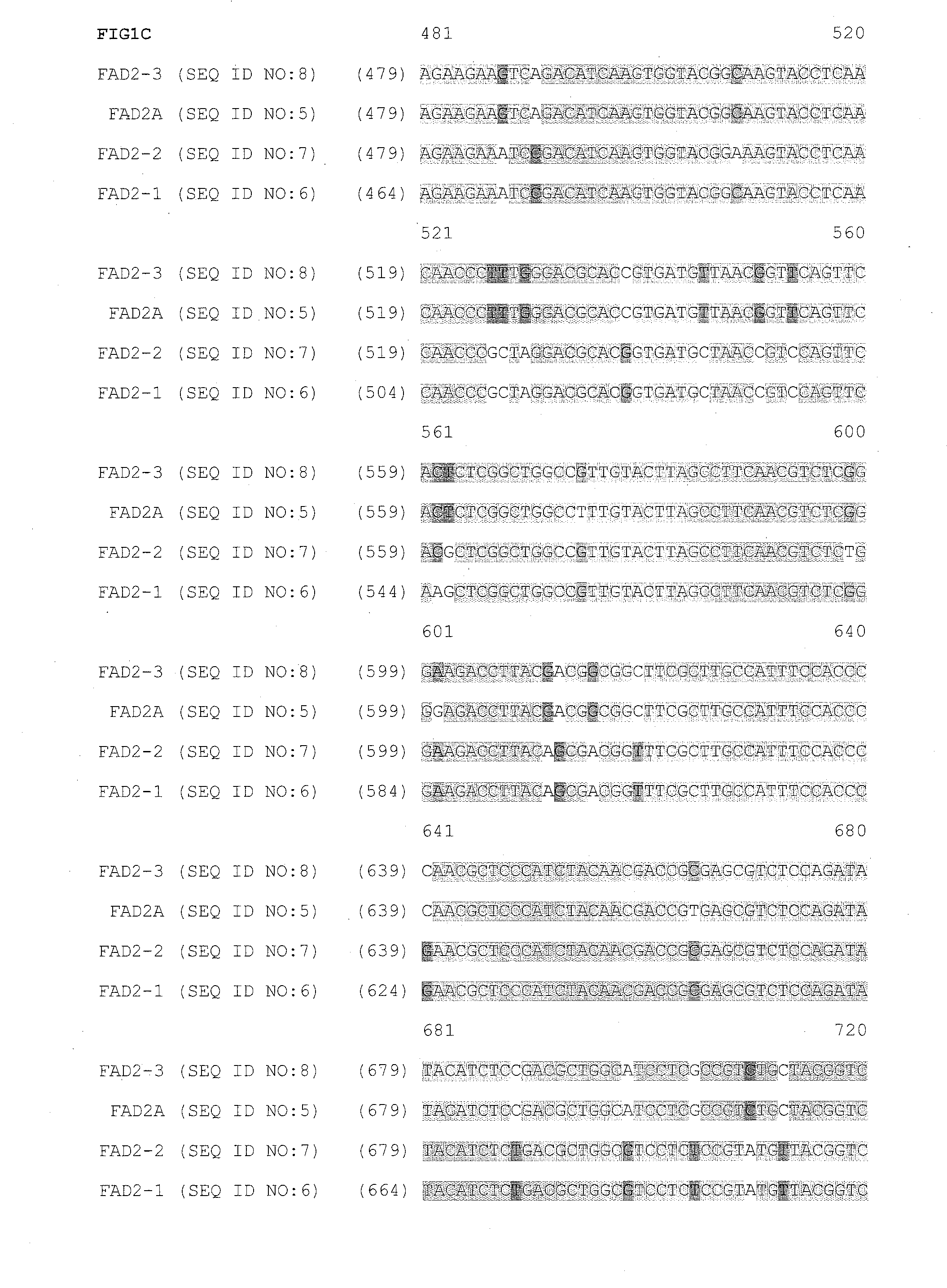Fad2 performance loci and corresponding target site specific binding proteins capable of inducing targeted breaks
a technology of fad2 and target site, which is applied in the field of recombinant plant technology, can solve the problems of inability to control the effect, affecting the expression level of integrated nucleic acids, and affecting or disturbing the normal function of the target region to produce undesirable side effects, so as to achieve the effect of minimal adverse impact on the agronomic performance of the hos
- Summary
- Abstract
- Description
- Claims
- Application Information
AI Technical Summary
Benefits of technology
Problems solved by technology
Method used
Image
Examples
example 1
Identification of FAD2 Target Sequences from a Bacterial Artificial Chromosome Library
BAC Library Construction
[0213]A Bacterial Artificial Chromosome (BAC) library was sourced from a commercial vendor (Amplicon Express, Pullman, Wash.). The BAC library included 110,592 BAC clones containing high molecular weight genomic DNA (gDNA) fragments isolated from Brassica napus L. var. DH10275. The gDNA was digested with either the BamHI or HindIII restriction enzyme. Isolated gDNA fragments of about 135 Kbp were ligated into the pCC1BAC vector (Epicentre, Madison, Wis.) and transformed into Escherichia coli str. DH10B (Invitrogen). The BAC library was made up of an even number of BAC clones that were constructed using the two different restriction enzymes. As such, the Hind III constructed BAC library was contained in 144 individual 384-well plates. Likewise, the BamHI constructed BAC library was contained in 144 individual 384-well plates. A total of 110,592 BAC clones were isolated and ar...
example 2
Design of Zinc Finger Binding Domains Specific to FAD2 Genes
[0225]Novel zinc finger proteins directed against DNA sequences encoding various functional sequences of the FAD2 gene locus were designed essentially as previously described. See, e.g., Urnov et al. (2005) Nature 435:646-651. Exemplary target sequence and recognition helices are shown in Table 4 (recognition helix regions designs) and Table 5 (target sites). In Table 5, nucleotides in the target site that are contacted by the ZFP recognition helices are indicated in uppercase letters; non-contacted nucleotides indicated in lowercase.
[0226]Zinc Finger Nuclease (ZFN) target sites were designed to bind five target sites of FAD2A. The FAD2A zinc finger designs were incorporated into zinc finger expression vectors encoding a protein having at least one finger with a CCHC structure. See, U.S. Patent Publication No. 2008 / 0182332. In particular, the last finger in each protein had a CCHC backbone for the recognition helix. The non...
example 3
Evaluation of Zinc Finger Nuclease Cleavage of FAD2 Genes
Construct Assembly
[0228]Plasmid vectors containing ZFN expression constructs of the exemplary zinc finger nucleases, which were identified using the yeast assay, as described in Example 2, were designed and completed using skills and techniques commonly known in the art. Each zinc finger-encoding sequence was fused to a sequence encoding an opaque-2 nuclear localization signal (Maddaloni et al. (1989) Nuc. Acids Res. 17(18):7532), that was positioned upstream of the zinc finger nuclease.
[0229]Next, the opaque-2 nuclear localization signal::zinc finger nuclease fusion sequence was paired with the complementary opaque-2 nuclear localization signal::zinc finger nuclease fusion sequence. As such, each construct included a single open reading frame comprised of two opaque-2 nuclear localization signal::zinc finger nuclease fusion sequences separated by the 2A sequence from Thosea asigna virus (Mattion et al. (1996) J. Virol. 70:812...
PUM
| Property | Measurement | Unit |
|---|---|---|
| volume | aaaaa | aaaaa |
| concentration | aaaaa | aaaaa |
| v/v | aaaaa | aaaaa |
Abstract
Description
Claims
Application Information
 Login to View More
Login to View More - R&D
- Intellectual Property
- Life Sciences
- Materials
- Tech Scout
- Unparalleled Data Quality
- Higher Quality Content
- 60% Fewer Hallucinations
Browse by: Latest US Patents, China's latest patents, Technical Efficacy Thesaurus, Application Domain, Technology Topic, Popular Technical Reports.
© 2025 PatSnap. All rights reserved.Legal|Privacy policy|Modern Slavery Act Transparency Statement|Sitemap|About US| Contact US: help@patsnap.com



